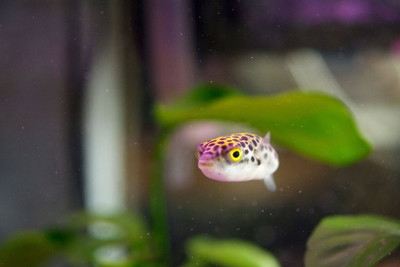Green Spotted PufferFish – Dichotomyctere nigroviridis
Posted by Max Gandara on on 17th Sep 2025
The Green Spotted Puffer Fish (Dichotomyctere nigroviridis) is a fascinating and highly intelligent species that stands out in the aquarium hobby for its striking appearance and lively behavior. Native to the brackish and freshwater rivers, estuaries, and coastal regions of Southeast Asia, this pufferfish is easily recognized by its vibrant green body covered in dark spots, contrasting with a pale belly. Its big, curious eyes and constantly active swimming make it an engaging and entertaining addition for experienced aquarists.
Unlike many community fish, the Green Spotted Puffer has a bold and inquisitive personality. These fish are known for their intelligence, often recognizing their keepers and eagerly following them around the tank. However, they are also semi-aggressive and best kept either alone or with carefully chosen tankmates. Their territorial instincts and tendency to nip fins make them unsuitable for most traditional community aquariums.
One of the most important aspects of keeping Green Spotted Puffers is providing the proper environment. While juveniles can tolerate freshwater, adults thrive in brackish water with increasing salinity as they mature. A spacious aquarium with plenty of hiding spots, plants, driftwood, and decorations will help reduce stress and allow them to explore and establish territories.
Feeding Green Spotted Puffers is another key part of their care. They are carnivores with strong beaks that continuously grow, so they need a diet that helps wear down their teeth. Offer a variety of hard-shelled foods such as snails, clams, shrimp, crabs, and other crustaceans, along with occasional frozen or live foods like bloodworms. This not only keeps them healthy but also prevents overgrown teeth, which can become a health issue if left unchecked.
With proper care, Green Spotted Puffers can live for many years and become truly interactive pets. Their vibrant coloration, playful behavior, and unique care requirements make them an ideal choice for aquarists looking for a more challenging and rewarding fish-keeping experience.

